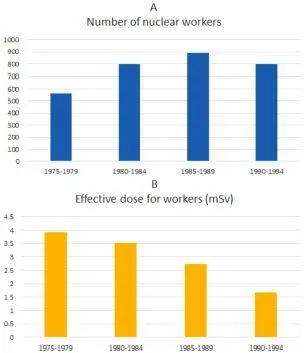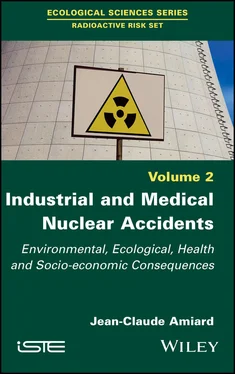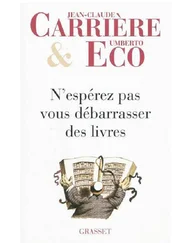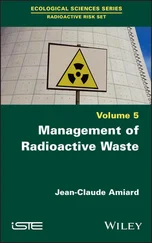A multi-analysis concerning miners was carried out by Lublin et al . [LUB 95]. It involved 11 cohorts of miners who had worked underground and included more than 27,000 lung cancer deaths among the 68,000 miners studied and almost 1.5 million person-years observed. This study found that the relative excess risk (RER) per UAM for lung cancer death was directly proportionate to the cumulative dose of PDR (ERR/UAM = 0.49%; 95% CI 0.2–1.0%).
Many questions remain about the risks of extra-pulmonary cancers (as the study by Bouet et al . above shows for liver cancer) and non-malignant diseases and about the health impact of other occupational radiological exposures [DRU 15].
2.8.2. Workers in the nuclear industry
In the absence of a nuclear accident, chronic exposure to ionizing radiation can have health consequences. For this reason, worker cohorts in the nuclear industry are being followed up medically.
In Oak Ridge, the observed number of 1,017 deaths from all causes was 74% of what was expected. This finding, which has been repeated several times, is based in particular on the cohort’s relatively high socio-economic status, associated with good health [CHE 83].
Among workers at a spent fuel reprocessing plant (Tennessee Eastman Corporation, USA), the relative risk of lung cancer increased with increasing exposure even after controlling age and smoking, but only for those over 45 years of age at first exposure [COO 83]. Among the 999 workers exposed to atmospheric uranium from 1943 to 1947 at the Tennessee reprocessing plant, the doses received were as high as 74 rads or 740 rems if a quality factor of 10 is used [BEC 83].
Among female watchmakers who used radium-based light dials, a tripling of the risk of multiple myeloma occurred in the cohort working before 1930. However, analyses of body burdens and duration of use suggest that external radiation due to radium was more likely to be responsible than internal radium [STE 83].
The impact of working in a nuclear environment is understood in France thanks to the TRACY cohort. This cohort of French fuel cycle workers was the subject of a reconstruction of occupational exposures [SAM 12, SAM 16]. According to the IRSN [IRS 17a], during the follow-up period (1968–2008) and with an average follow-up period of 27 years, 2,130 deaths (17% of workers) occurred. The mortality analysis shows a strong effect of the statistically significant “healthy worker” with an under-mortality of 35% compared to the national general population. Significant under-mortality is also observed for deaths by cancer pathology, non-cancer pathology and external causes. A single location presented a significant excess compared to the French population: pleural cancer (17 cases) with a standardized mortality ratio (SMR) of 2.04 (95% CI 1.19–3.27).
UNSCEAR [UNS 00b] reported 136 nuclear accidents with clinical consequences causing serious injuries to 90 nuclear workers, at least 40 of whom died within a few days. In addition, the same organization recorded 13 other accidents with clinical consequences for 368 workers, 13 of whom died. The normalized annual effective doses per unit of energy production were significantly higher for miners operating uranium mines. These doses decreased steadily from 1975 to 1994 due to radiation protection measures taken over time (Figure 2.5). The number of nuclear workers monitored for radiation increased from 1975 to 1989 and then stabilized, while the annual effective doses to workers steadily decreased (Figure 2.6).

Figure 2.5. Standardized collective effective dose per unit of energy production for various stages of the nuclear fuel cycle (mining, conversion, enrichment and fuel production) and for various time periods (adapted from [UNS 00b]). For a color version of the figure, see www.iste.co.uk/amiard/industrial.zip

Figure 2.6. Changes in the number of workers (in thousands) under surveillance (A) and of effective doses received (in mSv) by nuclear fuel cycle workers (B) according to four periods (adapted from [UNS 00b])
Beyea [BEY 06] tried to estimate the exposure of residents around the Santa Susana Field Laboratory (Simi Valley, USA) to help epidemiologists improve the effectiveness of their studies on radiation-induced diseases. This has been extremely complex, particularly from a meteorological point of view as a result of the particular climate of this region. In addition, the information available on radioactivity releases in the 1950s and 1960s is very limited. Exposures were dominated by the inhalation of radioactive iodine and ground deposition of radiocesium, since milk was a relatively minor source at this location. Out of the 20,000 simulations performed by Beyea, the average number of excess cancers was 260 (95% CI 0–1,800). In 25% of simulations, there were eight or fewer excess cancers; in half of the scenarios, the number of cancers was 50 or more, and in 2.5% of them, the number of cancers expected was 1,800 or more.
Nine specific or “radiosensitive” cancers revealed high incidence rates between 1988 and 1995 in people living within 2 miles of the SSFL. Specifically, the standardized incidence rate was greater than 1.6 for cancers of the blood and lymphatic tissues, bladder, thyroid and upper aerodigestive tract. Between 1996 and 2002, the prevalence rate among people living within 2 miles of the STPE was greater than 1.6 for thyroid cancer [MOR 07]. For his part, summarizing the various epidemiological studies of this site, Weitzberg [WEI 14] considers that no evidence of an increase in cancer in the population around Santa Susana has been scientifically demonstrated. It should be noted that the author probably had conflicts of interest with the company responsible for the accident, while the article by Morgenstern et al . (2007) was commissioned by the Agency for Toxic Substances and Disease Registry (ATSDR).
Epidemiological studies on workers at the SSFL site indicate a trend towards an increase in cancer mortality rate associated with an increase in the cumulative radiation dose to workers when this dose was external [RIT 99a, RIT 99b]. When this exposure was internal, Ritz et al . [RIT 00] also observed a trend between cumulative radiation exposure and cancer mortality (all types), mortality due to lymphopoietic cancers and of the upper aerodigestive tract, but not with lung cancer. On the other hand, Boice et al . [BOI 06] did not confirm this significant increase in cancer mortality in general or to a specific cancer among employees who worked at the SSFL site between 1948 and 1999.
Many class actions have been initiated by the population living around the SSFL site. After 7 years of litigation, 100 local residents received a US$30 million settlement following a trial. Information about the verdict and the conclusions found remains elusive, with only the settlement as proof of the conclusion [ROG 12]. In a study on clusters (disease outbreaks), Ingber and Ross [ING 11] consider that the Santa Susana site lacks evidence to be included in a first analysis.
Four hours after the accident began, approximately 50 families were evacuated within a radius of 350 m, 161 people living in 39 houses, and the area was closed to traffic [TAK 05a, TAK 05b]. In addition, approximately 320,000 residents residing within a 10 km radius were notified by loudspeakers, starting at 12:30 p.m. (2 hours after the onset of the chain reaction), to stay at home and close their windows. At 7 p.m., more than 5,000 families were still confined to their homes. A Tokai-Mura city official said the same day that the rain was facilitating the high radiation level in the vicinity of the accident site.
Читать дальше














